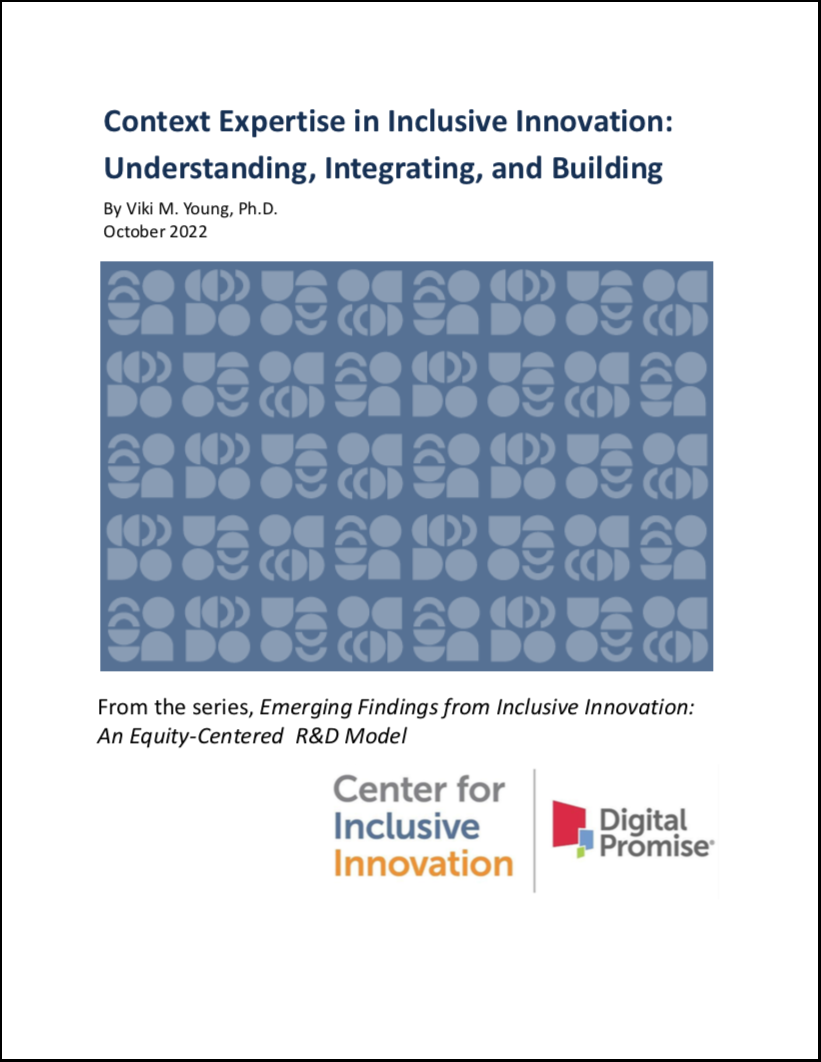The four community-district teams worked with Digital Promise to pilot the Inclusive Innovation model, and a Digital Promise team conducted cross-project research on five priority topics: the role of context expertise, the role of student voice, capacity building, racial equity, and the nature of outcomes in Inclusive Innovation.
This initial series, Emerging Findings from Inclusive Innovation, presents our learnings from 2021 to 2022. We share ongoing challenges, progress, and lessons based on our experiences with Inclusive Innovation so that as a field, we can generate demand and collectively drive inclusive and community-driven innovation that truly centers and benefits students, families and communities that are most impacted by barriers.
In 2024, we released two additional papers that continue to explore the emerging impacts of Inclusive Innovation; one on the empowerment and ownership experienced by district-community teams when they co-create solutions, and another on the factors that support sustainability of Inclusive Innovation work, such as lasting shifts in mindsets and practices.
Realizing District-Community Driven Outcomes Through Inclusive Innovation illustrates how Inclusive Innovation, through the co-creation of solutions by district-community teams focused on equity-centered outcomes, not only achieves perceived success in meeting those outcomes but also fosters a sense of empowerment and ownership among all participants.

Sustainability in Inclusive Innovation: District-Community Solutions, Mindsets, and Practices examines the factors that supported sustainability under Inclusive Innovation, including garnering buy-in at all levels of the system, iterating to improve implementation, embedding changes in existing structures, and concretely demonstrating the benefits of the solution. The paper also describes the mindsets participants developed and incorporated into their practices as a result of engaging in Inclusive Innovation.

Context Expertise in Inclusive Innovation: Understanding, Integrating, and Building underscores the ways in which Inclusive Innovation participants value context expertise, how context expertise contributed to the Inclusive Innovation process, and ongoing challenges and factors that facilitated and hindered the inclusion of context expertise.

In Their Own Words: Participants’ Perspectives on Honoring Student Voice takes a nontraditional approach by directly presenting what Inclusive Innovation participants say to illustrate what was most important about their experiences with Inclusive Innovation, the ways in which the model as implemented in each pilot project reflected student voice, and the ways in which we need to improve.

Capacity Building in Communities to Create Equity-Centered Educational Opportunities explores how participants developed mindsets for creating an environment that allows them to be vulnerable in sharing their lived experiences, to consider the perspectives of others, and to engage in co-leadership with one another. This paper also explores the knowledge, skills, and abilities for co-research and co-design that participants developed through their engagement in the Inclusive Innovation model.

Using Inclusive Innovation to Create Equity-Centered Outcomes focuses on the outcomes determined by community-district teams engaged in the Inclusive Innovation pilot projects and examines the extent to which the outcomes consider those with lived experiences with the challenge, teacher perspectives, and priority students’ needs, and how these outcomes align to specific district strategies and improvement plans.
